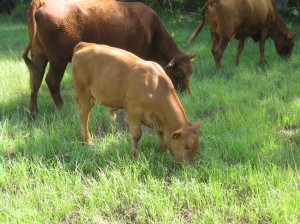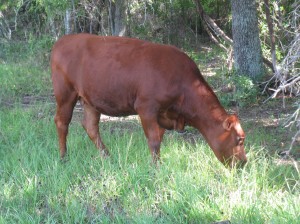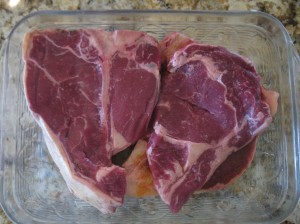 A fairly recent article (2010) summarizes the last 30 years of health and nutrition research on grass fed beef. The article is technical and scholarly which can make for slow reading. But it’s a tremendous resource that combines the various health benefits into a single article. I’ve heard many claims over the years and never knew which were verified by research and which were simply anecdotal or ‘folk’ legend. This article shows all the science behind these claims and confirms that grass fed beef is indeed much healthier than typical grain fed beef you’ll find at major grocery stores, and by a wide margin. Here’s a short summary version of this report. Please read the whole article for the details.
A fairly recent article (2010) summarizes the last 30 years of health and nutrition research on grass fed beef. The article is technical and scholarly which can make for slow reading. But it’s a tremendous resource that combines the various health benefits into a single article. I’ve heard many claims over the years and never knew which were verified by research and which were simply anecdotal or ‘folk’ legend. This article shows all the science behind these claims and confirms that grass fed beef is indeed much healthier than typical grain fed beef you’ll find at major grocery stores, and by a wide margin. Here’s a short summary version of this report. Please read the whole article for the details.
Omega 3 Fatty Acids
Two fatty acids are essential to human health and are not produced by the body – they come only from food. One is an Omega-6 type fatty acid and the other Omega-3. All beef contain both but studies have found it is the ratio of Omega 6 to Omega 3 that is important to overall health. A healthy diet has an overall ratio of one to four times more Omega-6 than Omega-3. In grass fed beef, the average ratio is about 2 to 1 – just what a healthy diet needs. Typical grain fed beef common to grocery stores have much less Omega 3 when compared to grass fed beef. This make the ratio for grain fed beef around 8 to 1 – far above the healthy range. The ratio is 4 times more favorable for grass fed over grain fed beef.
There are several important types of Omega-3 fatty acids. The article states that these:
“play a crucial role in the prevention of atherosclerosis, heart attack, depression and cancer. In addition, omega-3 consumption reduced the inflammation caused by rheumatoid arthritis….Several studies have established a correlation between low levels of omega-3 fatty acids and depression. High consumption of omega-3 fatty acids is typically associated with a lower incidence of depression, a decreased prevalence of age-related memory loss and a lower risk of developing Alzheimer’s disease”
The article cites studies confirming “cattle fed primarily grass significantly increased the omega-3 content of the meat and also produced a more favorable omega-6 to omega-3 ratio than grain-fed beef .”
Conjugated Linoleic Acids (CLA)
CLA is a group of fatty acids found in the meat and milk of ruminants such as cattle, sheep, etc. They are produced in the normal digestion of grass the animals eat. CLA declines as digestive pH decreases, and grain diets reduce digestive pH. So CLA in an animal raised on grass decreases when the animal begins to eat grain. The decline is significant over time, such that typical grain fed cattle produce less than half the CLA of grass fed animals. As a result, grass fed beef has more than double the CLA of grain-fed beef.
The article cites numerous studies showing significant health benefits attributed to CLA:
“actions to reduce atherosclerosis, and onset of diabetes … reduction of breast cancer in women… prevention of cancer in men and women…”
Vitamin A / Beta-Carotene
Carotenoids are synthesized in plants and pass into the milk and body fat of grass fed cattle. They are natural pigments that may give grass fed meat fat a yellowish color. Though some regard the yellow fat negatively, it is associated with a healthier fatty acid profile and higher antioxidant content. The article states beta-carotene is a precursor to Vitamin A which is:
“important for normal vision, bone growth, reproduction, cell division, and cell differentiation … responsible for maintaining the surface lining of the eyes and also the lining of the respiratory, urinary, and intestinal tracts. The overall integrity of skin and mucous membranes is maintained by Vitamin A, creating a barrier to bacterial and viral infection. In addition, Vitamin A is involved in the regulation of immune function by supporting the production and function of white blood cells”
Grass fed cattle were found to have 7 times more beta-carotene compared to grain-fed cattle.

Cattle enjoy the variety of natural grasses and forages found in the meadows and woodlands of Blessing Falls Farm
Vitamin E, another fat soluble vitamin, exists in eight different isoforms that have powerful antioxidant activity. The most active isoform is alpha-tocopherol. The article cites several studies showing grass fed cattle having average alpha-tocopherol levels 3 times higher than grain fed cattle.
“Antioxidants such as vitamin E protect cells against the effects of free radicals. Free radicals are potentially damaging by-products of metabolism that may contribute to the development of chronic diseases such as cancer and cardiovascular disease…. Preliminary research shows vitamin E supplementation may help prevent or delay coronary heart disease…, block the formation of nitrosamines, which are carcinogens formed in the stomach from nitrates consumed in the diet…, enhance immune function… observational studies found lens clarity (a diagnostic tool for cataracts) was better in patients who regularly used vitamin E.”
The article further cites studies showing that increased Vitamin E extends the shelf-life and improves the red color of grass fed beef compared to grain fed.
Antioxidant Enzymes
Glutathione (GT) is a newly identified food protein. Within cells,
“GT has the capability of quenching free radicals (like hydrogen peroxide), thus protecting the cell from oxidized lipids or proteins and preventing damage to DNA.”
GT is higher in green forages, so “grass-fed beef is particularly high in GT as compared to grain-fed”. Grass fed beef is also higher in superoxide dismutase and catalase – coupled enzymes that work together as powerful cancer fighting antioxidants.
Conclusion
The article concludes:
“Research spanning three decades supports the argument that grass-fed beef has a more desirable cholesterol profile as compared to grain-fed beef. Grass-finished beef is also higher in total CLA … and Omega-3…. This results in a better Omega-6:Omega-3 ratio that is preferred by the nutritional community. Grass-fed beef is also higher in precursors for Vitamin A and E and cancer fighting antioxidants such as GT and SOD activity as compared to grain-fed contemporaries.”
We encourage you to read the complete article and stop by the market or contact us with any questions or comments.
Reference: http://www.nutritionj.com/content/9/1/10
More on Health Benefits of Grass Fed Beef
EatWild: http://www.eatwild.com/healthbenefits.htm
Mayo Clinic: http://www.mayoclinic.com/health/grass-fed-beef/AN02053
Integrated Fitness: http://if-fit.com/the-benefits-of-grass-fed-beef/

